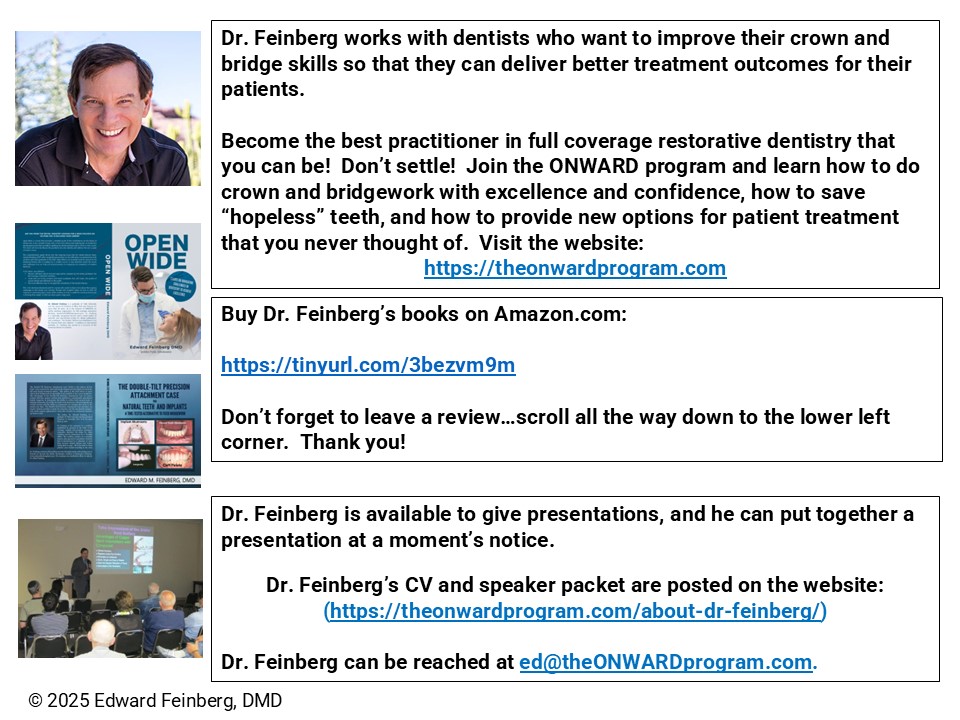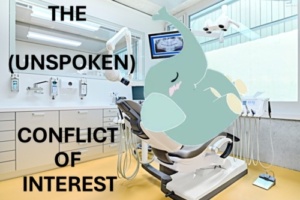
Dental Social Media Groups: Bastions of “Groupthink”
I admit it! I am a social media junkie. I love hanging out in Facebook’s dental groups. I’m particularly curious about what my colleagues are thinking and about the overall vibes shaping the Dental profession. What I have found in dental social media sites, however, is often upsetting and somewhat alarming. It appears to me that many of my social media dental colleagues have never left “dental kindergarten.”
One day, as I was stalking one of the groups under cover, I spied one of my colleagues posting information about a patient. There was an attached X-Ray featuring a broken implant surrounded by teeth that already had crowns on them. The dentist was unsure about how to proceed and asked for help.
Of course I volunteered to help! I consider it my duty and my mission to help because I was helped. For this reason, I created a teaching website devoted to teaching dentists crown and bridge techniques that have 70 years of documented evidence for their efficacy. [www.theONWARDprogram.com] Basic principles of science and engineering have allowed me, my father and my father’s teacher to have an unusually high percentage of success, even for cases deemed “hopeless.” These principles are not taught in any dental school or dental institute.
There are more than 35 courses available on the website, and they are replete with crown and bridge case examples that have lasted in health for decades. X-Ray documentation overwhelmingly demonstrates that periodontal bone loss and recurrent decay is minimized or eliminated. I have seen few educators over the course of my career present cases with this level of documentation. Most do not show ANY follow-up whatsoever.
Because most dentists do not have confidence with their crown and bridge skills, the answer to almost every restorative problem today involves implant therapy—and often that therapy is excessively invasive. Another factor contributing to the overuse and inappropriate use of implants stems from the implant manufacturers. These corporate entities are fueling the use of implants to maximize profits. They are major sponsors of continuing education, so dental continuing education courses today seem to be almost exclusively implant-focused. The famous psychologist Abraham Maslow pointed out in his book Psychology of Science, that “if all you have is a hammer, everything looks like a nail1.” Most dentists only have implant therapy in their treatment armamentaria, so implant therapy has become a first resort, rather than a last resort.
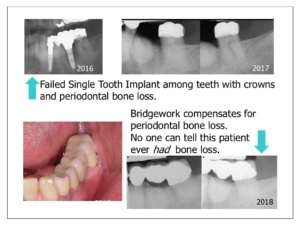 Unfortunately, the treatment of every edentulous space with an implant is a piecemeal approach to dental care, rather than an overall approach that is focused on creating health, preventing future problems and maximizing case longevity. Contrary to popular belief, full coverage crown and bridge restorations are not simply tooth “coverings.” They are corrective. Bridgework can solve restorative problems in an entire quadrant by bringing the forces closer to the bone to compensate for periodontal bone loss, changing the architecture to minimize forces on the supporting structure and sealing the teeth against recurrent decay. By contrast, a single tooth implant only fills a space and does nothing for the teeth around them. The patient ends up with a hodgepodge of dental restorations and dental problems are never solved. The single tooth implant has become the poster child for piecemeal thinking. Piecemeal thinkers serve patients more like mechanics than like doctors.
Unfortunately, the treatment of every edentulous space with an implant is a piecemeal approach to dental care, rather than an overall approach that is focused on creating health, preventing future problems and maximizing case longevity. Contrary to popular belief, full coverage crown and bridge restorations are not simply tooth “coverings.” They are corrective. Bridgework can solve restorative problems in an entire quadrant by bringing the forces closer to the bone to compensate for periodontal bone loss, changing the architecture to minimize forces on the supporting structure and sealing the teeth against recurrent decay. By contrast, a single tooth implant only fills a space and does nothing for the teeth around them. The patient ends up with a hodgepodge of dental restorations and dental problems are never solved. The single tooth implant has become the poster child for piecemeal thinking. Piecemeal thinkers serve patients more like mechanics than like doctors.
With the best of intentions, I emerged from the digital shadows to help my confused colleague. I pointed out that placing a single tooth implant among teeth that have crowns, or large restorations that will need crowns makes no sense when bridgework can do so much more for the patient than a single tooth implant. The teeth in the presented X-Rays were clearly not “virginal,” as they have crowns on them. It should be a no-brainer to remove the crowns and make bridgework. But as they say, “common sense is not common.” I directed my colleague to visit my teaching website to learn how to create ideal dentistry with a real track record.
As soon as I volunteered advice, internet “furies” swooped down on me out of nowhere. Several group members accused me of opportunism, and they scolded me for trying to exploit my confused colleague. I countered by explaining that the ONWARD organization was nonprofit and that I do not personally profit from any of the courses. The courses are either free or inexpensive. I informed them that I am only trying to give back that which was given to me and that if they messaged me in private, I would give them a code that would enable them to attend all the courses for free AND receive CE credit for all of them. If they showed interest, I would be happy to personally mentor them. I desperately want to be a mentor, but I have yet to find a single young practitioner who wants one! When I started my career, dentists would have given their “eye teeth” to have someone like me as a mentor. Think about that!
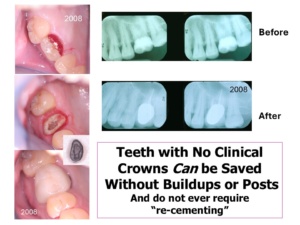
My Facebook colleagues were skeptical of the skills I said my website could teach them, such as the ability to restore teeth flush with the gingiva without posts, buildups, fancy orthodontic extrusion or extensive periodontal crown lengthening. I can accomplish seemingly impossible tasks because I do not share their indoctrinated myths and misconceptions. I was trained with a completely different approach to full coverage restorative dentistry. But rather than checking the website to see for themselves, I was subjected to ridicule.
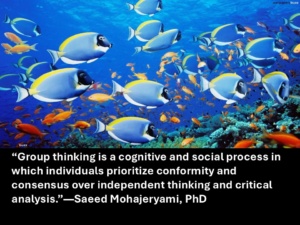 Social psychologist Irving Janus coined a term for this type of behavior. He called it “groupthink.” According to Dr. Janus, groupthink occurs when individuals are so deeply involved in a cohesive in-group that their strivings for unanimity override their motivation to realistically appraise alternative courses of action. He says that the allure of groupthink is powerful on social media as we are constantly bombarded with technologies, information and challenging worldviews. Dr. Janus adds that people usually don’t think before participating in the “herd discussion.” Behavior might also be subtly influenced by social media platform algorithms. Author Jaron Lanier points out that
Social psychologist Irving Janus coined a term for this type of behavior. He called it “groupthink.” According to Dr. Janus, groupthink occurs when individuals are so deeply involved in a cohesive in-group that their strivings for unanimity override their motivation to realistically appraise alternative courses of action. He says that the allure of groupthink is powerful on social media as we are constantly bombarded with technologies, information and challenging worldviews. Dr. Janus adds that people usually don’t think before participating in the “herd discussion.” Behavior might also be subtly influenced by social media platform algorithms. Author Jaron Lanier points out that
“We’re being tracked and measured constantly, and receiving engineered feedback all the time. We’re being hypnotized little by little by technicians we can’t see for purposes we don’t know. We’re all lab animals now3.”
Saeed Mohajeryami, PhD outlines the contributing factors to “groupthink4” in his essay “The Psychology of Group Thinking: How Our Social Identity Affects Decision Making:”
-
- Social identity theory suggests that individuals tend to identify strongly with their group and seek to conform to group norms.
- Cognitive dissonance theory proposes that individuals experience discomfort when their beliefs or actions conflict with the group’s opinion.
- Group polarization occurs when group members become more extreme in their opinions and actions after discussing them with other group members.
- Additional factors include size and structure of the group, the influence of charismatic leaders and the desire for social approval and acceptance.
Believe it or not, my recent trampling by the “groupthink” stampede was not my first rodeo. It seems to me that the same scenario occurs every time I try to help someone in a social media dental group. What’s most upsetting to me is that none of my social media colleagues are even the slightest bit curious about visiting the website or about giving me the benefit of any doubt. Sitting on their “high horse,” they somehow feel entitled to pass judgment without examining any facts whatsoever. But, as Aldous Huxley once said, “facts do not cease to exist because they are ignored.”
It is my observation that the current generation of dentists is a lot less interested in learning than previous generations. I have given presentations all over the country and as a rule most of the attendees tend to be older rather than younger.
There also seems to be an unspoken prejudice that experienced practitioners are “old- fashioned” and that they don’t know how to use technology. They are wrong. I am no luddite. I have taken computers apart and I am quite adept at grasping technological and digital concepts. However, because of my experience, I can easily discern the difference between good technology and bad technology. I have a lens of basic principles that I use to evaluate anything new that comes down the pike. But most of my colleagues seem to have no clue what these basic principles are, so they are easy prey for a lot of bad technology peddled by corporate entities.
 The Greek philosopher Epictetus once commented that “it is impossible for a man to learn what he thinks he already knows.” Many social media Facebook colleagues impress me as “know-it-alls.” How did they get to be so smart? I had to study hard and practice under the stern eye of a tough taskmaster for years to achieve a high level of knowledge and excellence in skills. I still take continuing education courses because I do not know everything, and I always want to do better. I also want to see what is being done “out there” even if I don’t agree. I am not afraid to adopt new technology when it conforms to the basic principles that I believe in. It is my observation that not only are my social media Facebook colleagues uninterested in learning, but they lack critical thinking skills as well. They don’t know how to come up with out-of-the-box solutions for challenging individuals and they don’t have enough treatment options in their armamentarium to offer their patients.
The Greek philosopher Epictetus once commented that “it is impossible for a man to learn what he thinks he already knows.” Many social media Facebook colleagues impress me as “know-it-alls.” How did they get to be so smart? I had to study hard and practice under the stern eye of a tough taskmaster for years to achieve a high level of knowledge and excellence in skills. I still take continuing education courses because I do not know everything, and I always want to do better. I also want to see what is being done “out there” even if I don’t agree. I am not afraid to adopt new technology when it conforms to the basic principles that I believe in. It is my observation that not only are my social media Facebook colleagues uninterested in learning, but they lack critical thinking skills as well. They don’t know how to come up with out-of-the-box solutions for challenging individuals and they don’t have enough treatment options in their armamentarium to offer their patients.
I can only conclude that dental social media groups are the ultimate bastions of “groupthink” where members dare not veer from indoctrinated belief. Very few have the courage to openly question what they have been taught. Anyone visiting the group who thinks differently is ostracized with lightning speed. I have overwhelming evidence that their indoctrinated beliefs are wrong. “Wrong does not cease to be wrong,” famous author Leo Tolstoy once said, “because the majority share in it.”
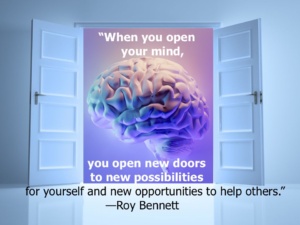 Jack Kerouac takes this thought one step further. He maintains that “great things are not accomplished by those who yield to trends and fads and popular opinion.” History shows that he is right. As a result, I believe that “groupthink” stagnates the entire dental profession. When group thinkers extend their control from social media to the academic institutions and academic stages, they become gatekeepers who prevent new ideas from being presented and discussed.
Jack Kerouac takes this thought one step further. He maintains that “great things are not accomplished by those who yield to trends and fads and popular opinion.” History shows that he is right. As a result, I believe that “groupthink” stagnates the entire dental profession. When group thinkers extend their control from social media to the academic institutions and academic stages, they become gatekeepers who prevent new ideas from being presented and discussed.
Close-mindedness will ensure that dental practitioners never rise to their true potential. If dental leaders truly want to raise the standard of dental care, they must inspire practitioners to be respectful of their colleagues and be on their guard against “groupthink.” The very best practitioners in Dentistry are critical thinkers. Leaders must inspire their colleagues to want to better themselves—and not just pursue implant therapy because it is lucrative. There are abundant continuing education opportunities already available—both in-person and online. Perhaps dental social media groups could evolve into open-minded sources of education. It would be nice to have a forum devoted to examining new approaches to dentistry that differ from mainstream dogma.
It is no secret that the dental profession faces uncertainty and difficult challenges. Where is the profession going? Decisions will be made this year both individually and collectively. British author Alex Morritt’s new year’s remark is á propos:
“New year—a new chapter, new verse, or just the same old story? Ultimately, we write it. The choice is ours.”
Let’s make 2025 a year when Dentistry charts a new course—one in which all practitioners open their minds, respect and help one another, and strive to be the very best that they can be.

1Wikipedia, “Law of the Instrument,” https://en.wikipedia.org/wiki/Law_of_the_instrument.
2Dahunsi, Lanre; “The Allure of Groupthink in the Age of Social Media;” Insight; May 11, 2021; https://www.lanredahunsi.com/the-allure-of-groupthink-in-the-age-of-social-media/
3Dahunsi, Lanre; “Book Summary: Ten Arguments for Deleting Your Social Media Accounts Right Now by Jaron Lanier;” http://35.180.141.45/book-summary-ten-arguments-for-deleting-your-social-media-accounts-right-now-by-jaron-lanier/
4Mohajeryami, Saeed PhD; “The Psychology of Group Thinking: How Our Social Identity Affects Decision Making;” March 24, 2023; https://medium.com/mi https://medium.com/mind-talk/the-psychology-of-group-thinking-how-our-social-identity-affects-decision-making-f6b4f93df9b9.
©Edward Feinberg DMD, 2025
